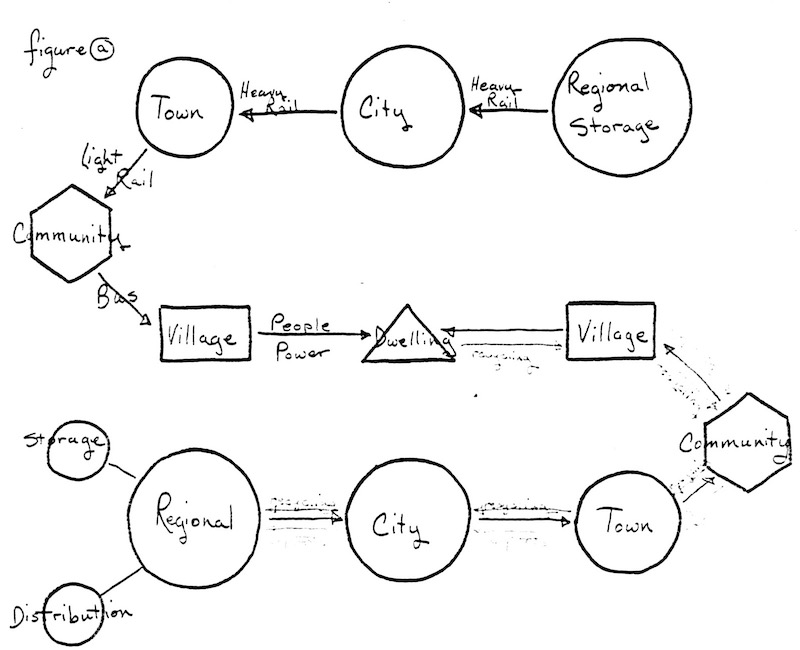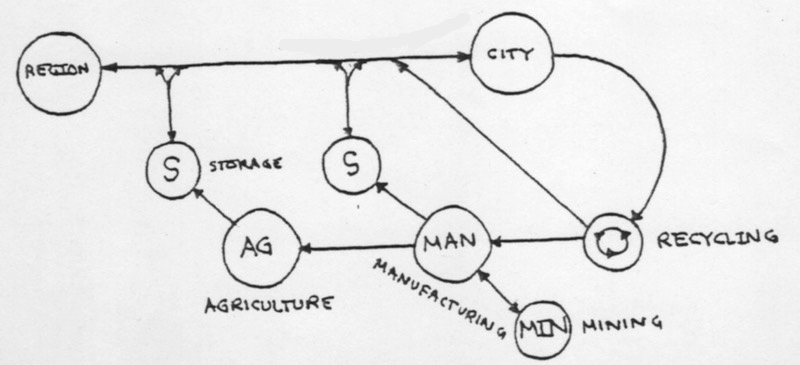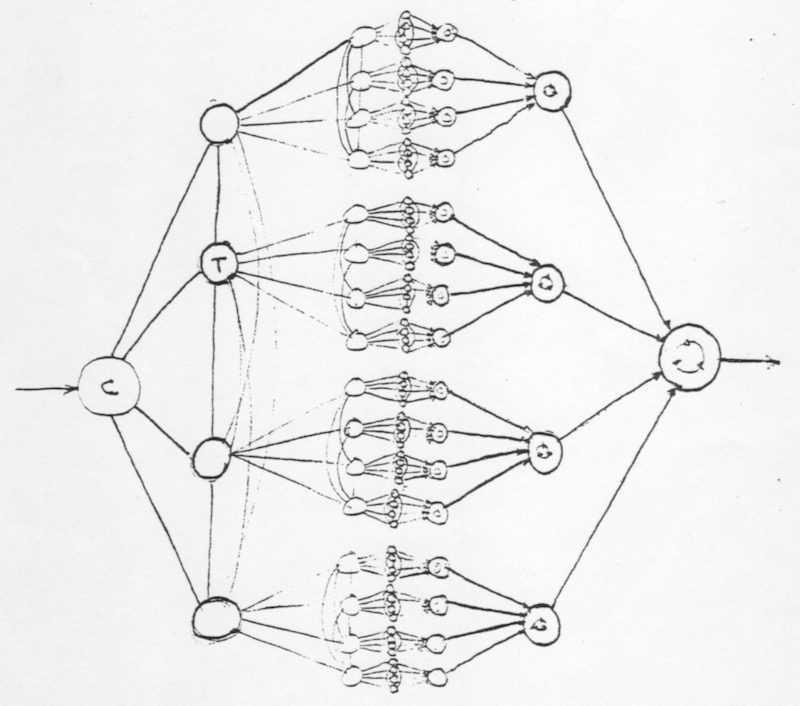
Pure Heavy industrial areas are distinct from residential and heavy freight is handled with differing technologies. But small scale (lightweight) commercial and industrial units could flow in and out on mixed transportation routes.
No zip codes or postal codes necessary - just world model global addresses.
Now for the original papers and diagrams. Sorry for poor quality of figures at this time, Dec 2018 --jm
The lifeblood of the city is the goods required to keep it functioning, as well as the recycle who live in it. The system of transportation is like the circulatory system, supply-ins food and goods to where they are needed as well as taking away recyclable materials and goods produced that cannot be used by that community,(exports). ??
The system would consist of nodes being (from greatest to least amounts of goods and/or people transferred): regional or city storage facilities, city depot, town depot, community depot, village depot, and dwelling. Edges would be heavy rail transport between storage and city, and between city and town; a lighter-gauge rail transport between town and community; and a bus system between community and village. People-powered units (i.e., bikes would serve between village and dwelling.
Each link is a back-and-forth system which travels the same route servicing the same two points. Furthermore, entire system is set up so that each one-way trip, or pulse, takes the same amount of time, regardless of the distance. This is achieved by utilizing a mode capable of the necessary speed. This feature is the heart of how it can function efficiently and conveniently.
Cargo would use a 30-minute sorting time between cycles. Typical schedule would have buses/trains leaving on the quarter hour, arriving at their destination 10 minutes later; this leaves a 5-minute layover in which people would change cars and full cargo containers moving down the line would be exchanged for empties, recycling, and mail moving back up the line. All handling would take place during the half-hour wait between cycles, in which containers would be either moved to where they could be loaded onto the next train going in the proper direction or stored temporarily if no space were available.
The number of freight cars per train would remain relatively constant in order to provide adequate service on a reliable basis; due to the large capacity of the system, cargo would be transported fairly easily and conveniently for everyone concerned. Cargo use of the system would, however, be limited to those cycles which would assure delivery of that cargo to its destination or to an adequate storage facility by the time the system shut down for the night. In considering travel time for a particular cargo, 15 minutes must be allowed per edge, and a half-hour per each node en route. For instance, a cargo unit from the storage, bound for the community center would leave the storage center no later than the 7th-to-the-last pulse of the day.

Cargo would be transported in bulk only as far as the community level (except for the mail, which would go to the village postal office by bus.) All other bulk distribution would be carried out at the community level. People would acquire their goods there; transportation then becomes the individual's responsibility. In most cases, the bus system would provide quite adequate service.
The considerations for which mode of transportation to use would be based on the number of people served. Between the storage center and the city & town, a heavy rail system using flat cars for containers of cargo, and passenger cars, would be most appropriate. For the link between town and community center, a lighter rail system capable of carrying a fractional amount of the cargo moving down the line, equal to one over the number of communities served on this link.
Due to the great frequency of pulses, the system will not be required to handle too much at one time, in one pulse. This will mean a minimum of storage along the route as well as at its destination, due to the rapid response time in which the storage facilities can send something along.
I have largely passed over passenger transportation since it is so much simpler in nature. A minimum number of passenger cars will be on the line, with the potential of adding extra cars to accomodate special events or seasons.
Editor's note: I think we came up with this idea about half and 1/4 containers after Andy had already type written his paper. --jm

Figure B. - Typical heavy gauge flat car / containers.
Ideally, a city would be a living space without manufacturing and certainly would not be in wheatfields, forests, and fishing grounds, but would have all these things available to it. Simply, the arrangement would look like this:

where the imports and exports are goods not avainble in thie geographic region of the city. Really, any particular region contains only a subset of the resources available world-wide. Acknoweledging this geographic reality, a more satisfactory arrangement is:

In this schema, the distribution center is able to take up the slack in the national system by shipping surplus where it is needed. Note that national management of production and distribution would result in less waste. A more detailed diagram of the same system model is:

In this model, storage facilities act as a buffer, and as a surplus/need sorting point. Inventory communication links allow virtual inventory to be known in advance of arrival at storage for use in computation. Distribution of this inventory is the topic of 'Central Economic Distribution' elsewhere in this work. Once the amounts of goods are allocated, their optimal shipment can be computed on a national or world-wide basis. National distribution and shipping moves huge quantities of grain and materials, but is actually quite simple.
The distribution system for the city is far more intricate as its job is delivering goods to the cellular level of society. In keeping with the capillary analogy, city distribution looks like this:

Goods flowing into the city are routed along predetermined paths to their destiny. At each node a distribution center performs two basic functions:

Particles flowing down through the syster are sorted; those flowing up are merged. parking on containers would indicate each sucessive sorting route. Scheduling of containers by size, destination, and priority would be computed d.ily to streamline and smoth the flow. merging will not require as much scheduling, since containers would be being returned to their source.
A subsystem of distribution would be the mail. It fits nicely into the tree structure. The village post office has boxes for each dwelling. It also has a seven slot pre-sorting station, one slot for each level of community: village, community, town, city, region, nation, and world:

A letter would be sent only to the highest level required for it to be routed to its destination by the post office at that level. The village mail never leaves the village. Cormunity mail goes as far as the community before being sorted. In general, a piece would be carried directly to its highest point and then begin its descent. An error in pre-sorting would cause a delay of several sorting cycles before it would be on route again. Persons would gain appreciation for the system during their development years.